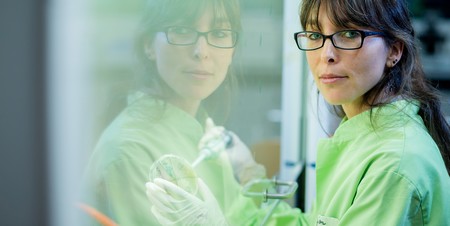A new way to fight antimicrobial resistance
World Antimicrobial Awareness Week is celebrated every year from 18-24 November. During this week, the World Health Organization reminds the world that drugs to fight bacteria, viruses, fungi, or parasites can lose their effectiveness, which leads to some 700,000 deaths per year. Antimicrobial resistance has been a focus point for many researchers at the University of Groningen. Microbiologist Marjon de Vos is working on a novel approach to tackle the problem, based on ecology and evolution.
Infections are usually treated using a straightforward paradigm: an infectious agent causes the patient’s illness, so the cure is a drug that kills the agent. This paradigm works but reality is often much more complex, explains Marjon de Vos, assistant professor of Microbiology at the University of Groningen. ‘Treatment with antimicrobials produces a selection pressure towards resistance. And this happens within a microbial community with more than one species.’

Interventions
Fighting this resistance is complex. Antimicrobials should be used sparingly but effectively. ‘You don’t want to prescribe antibiotics for a cold and treatments can sometimes be stopped when there are no longer any symptoms,’ explains De Vos. In the Netherlands, awareness of such basic rules is high, she adds. Another approach is to develop new antimicrobials that evade resistance. ‘However, there are not many new drugs in the pipeline.’
Together with her colleagues, De Vos is working on a third approach. ‘The paradigm of one infectious agent is too simple; infections often take place within a microbial community,’ she explains. ‘We need to understand how these species interact and contribute to the spread of resistance genes or to the increased growth of pathogens.’ PhD student Timo van Eldijk is working on these questions in the departments of Theoretical Biology and Molecular Genetics. ‘If you understand these ecological and evolutionary processes, you can come up with interventions,’ he explains.

Stress response
Probiotics, bacteria that support health, are one way to intervene in bacterial communities. Yet even there, the focus is often on one type of probiotic species, which is too limited, explains De Vos: ‘We need to understand the ecological interactions in the microbial community. What kind of signals are being given? What roles do different species play within the ecosystem and how are resistance genes transferred?’ The ideal solution would be to adapt the signals in such a way that, for example, the growth of pathogens is limited or their attachment to the body is reduced.
Such ecosystem interactions are often difficult to study. ‘Fortunately, with microorganisms, you can study these interactions relatively easily in the laboratory or via simulations,’ explains Van Eldijk. ‘This allows us to find ways to reduce selection pressure towards resistance or the transfer of resistance genes. For example, by reducing the stress response in bacteria, you might be able to reduce horizontal gene transfer, the exchange of genes between bacterial species, which could reduce the spread of resistance genes.’ The aim is to discover ways to fight bacteria with bacteria.

Treatment options
De Vos: ‘We have already identified certain signatures of species in urinary tract infections. The primary culprit is the E. coli bacterium but this bacterium is often supported by certain other species. We are using this knowledge to determine ways in which we can add species to perturb the infectious ecosystem.’ De Vos and her colleagues plan to investigate the ecological interactions between infectious agents and the urinary microbiome. ‘By observing such small microbiome communities over time, we hope to discover ecological tipping points that are important for infection.’
Ecological interactions can lead to evolutionary changes in the genome of pathogens. Together with her colleagues, De Vos published a short review paper on evolutionary medicine in The Lancet Infectious Diseases two years ago, based on the cross-fertilization of clinical, ecological, and evolutionary knowledge of infectious diseases. De Vos: ‘We need to understand how ecological and evolutionary interactions shape antimicrobial resistance. This will help us to develop new treatment options.’
See also:
- WHO World Antimicrobial Awareness Week
- Marjon de Vos lab
- Under the auspices of the Royal Netherlands Academy of Sciences (KNAW), the University of Groningen organized the Antibiotics Now! conference in 2016. A journalistic report can be read online.
More news
-
15 September 2025
Successful visit to the UG by Rector of Institut Teknologi Bandung
